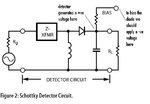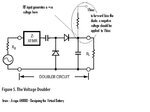per_lube
Advanced Member level 4
Hi,
I saw the following cct. diagram in Avago AN1088: Designing the Virtual Battery.

What I understand is to bias the detector diode to reduce the impedance of it, a negative (-ve) DC voltage should be supplied when there's no RF input.
However, when there's an RF input, a positive voltage getting created at the cathode of the diode.
Then it becomes a +ve voltage from RF input and -ve voltage of the DC bias supply at the same point which becomes a short circuit.
I know this shouldn't be what's happening there.
Could anyone help me to understand to apply proper bias for this circuit?
Then in voltage doubler circuit, if I add a -ve DC bias voltage as shown below, again when there's no RF input, the two diodes become forward bias.
Similar to the previous situation, when there's an RF input, the doubler output generates a +ve voltage and bias pulls down to a negative voltage.

I made the following doubler circuit.

When there's RF in, and no bias voltage, the doubler gives out a negative voltage output.
When I apply the positive bias and apply a 12 GHz RF input, the circuit does not work and diodes burns out.
Could you please tell me what's the problem here and how to properly bias the these circuits?
cheers,
per_lube
I saw the following cct. diagram in Avago AN1088: Designing the Virtual Battery.

What I understand is to bias the detector diode to reduce the impedance of it, a negative (-ve) DC voltage should be supplied when there's no RF input.
However, when there's an RF input, a positive voltage getting created at the cathode of the diode.
Then it becomes a +ve voltage from RF input and -ve voltage of the DC bias supply at the same point which becomes a short circuit.
I know this shouldn't be what's happening there.
Could anyone help me to understand to apply proper bias for this circuit?
Then in voltage doubler circuit, if I add a -ve DC bias voltage as shown below, again when there's no RF input, the two diodes become forward bias.
Similar to the previous situation, when there's an RF input, the doubler output generates a +ve voltage and bias pulls down to a negative voltage.

I made the following doubler circuit.

When there's RF in, and no bias voltage, the doubler gives out a negative voltage output.
When I apply the positive bias and apply a 12 GHz RF input, the circuit does not work and diodes burns out.
Could you please tell me what's the problem here and how to properly bias the these circuits?
cheers,
per_lube
Last edited: